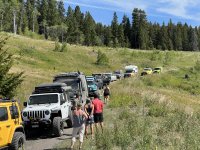1stgenoverland
Adventurer
Oh sweet! I'll go have a peruseOh whoops.. my bad, I just assumed there was a link in my signature...... but apparently not haha. Here:
https://forum.expeditionportal.com/threads/1998-5-dodge-ram-ctd-sally.167293/
Oh sweet! I'll go have a peruseOh whoops.. my bad, I just assumed there was a link in my signature...... but apparently not haha. Here:
https://forum.expeditionportal.com/threads/1998-5-dodge-ram-ctd-sally.167293/
Honestly inspired. I skimmed through it and stopped on the fab stuff. An inspiring amount of skill you have. I hope I reach that level one day. For now, I'll just keep plugging away at my list.Good luck! It's....... detail intensive haha. On that note, loving the detail you're getting into.. great to see!
I know I got this, I fabricated a good number of things over the years. Aluminum pod for the boat, a couple flat decks, landings, exhaust systems... there's more, but I still have this little edge to me, every time I'm about to do something new.Heck yeah man, you got this!
I also have a Steed Speed exhaust manifold, and couldn't agree more with what you said about it. I have a PDD 362sxe and the turbo has no issue keeping it happily fed with exhuast at 1300 or 2100rpm, and transient response is fantastic and linear (no crazy short-lived ski jump boost spike).
I have a Mishimoto aftermarket intercooler which I did some mods to.. however if memory serves correct, it should still be about +15% in flow area relative to the charge air flow direction.
I deleted the grid heater for simplicity (and realistically not really needed with the lowest temps in our climate), but still have the factory intake manifold because.... it fits. I'd be curious to know if there are any intake elbow differences between a 1st gen VE 12V and a 2nd gen 12V/24V.
Do you have any plans for VE fueling, or just turn it up a hair to keep the truck moving its own weight handily, but still maintain reliability and EGT's..?
I should add. I'm installing a set of dynamite diesels pilot hole injectors. The technology is incredible, and they have a promotion out right now, where, for $400 US, you can send you injectors in, they'll rebuild them with the Pilot hole tips, and ship them back to you. I highly suggest watching a few of their videos on YouTube but the basics of it is this. They have two small pilot holes near the tip, and then 4 main holes above them. At idle, the pintle in the injector only opens enough to let the two holes flow fuel. What you get is a super fine mist of fuel that burns incredibly well, and gets rid of the idle haze and a lot of the noise. They are also the main holes being used under low loads and low rpm. When you start pushing into the throttle, the pintle raises high enough to expose the 4 larger holes and you now pass enough fuel for higher rpm and load. But the pilot holes still are active, and the super fine mist of fuel they spray, milliseconds before the 4 holes are exposed, gets the flame front going, making the 4 holes inject into an already burning combustion chamber. You get an incredibly clean burn this way, and this is roughly what is happening in modern diesel engines, with electronically controlled fuel injectors. Only they are having up to 7 injection events per power stroke. Some advanced and some retarded.Do you have any plans for VE fueling, or just turn it up a hair to keep the truck moving its own weight handily, but still maintain reliability and EGT's..?





That's really cool! Very awesome to see effort still being put into these old [reliable/simple/cool] 12V motors to keep them running better and cleaner at the same time.I should add. I'm installing a set of dynamite diesels pilot hole injectors. The technology is incredible, and they have a promotion out right now, where, for $400 US, you can send you injectors in, they'll rebuild them with the Pilot hole tips, and ship them back to you. I highly suggest watching a few of their videos on YouTube but the basics of it is this. They have two small pilot holes near the tip, and then 4 main holes above them. At idle, the pintle in the injector only opens enough to let the two holes flow fuel. What you get is a super fine mist of fuel that burns incredibly well, and gets rid of the idle haze and a lot of the noise. They are also the main holes being used under low loads and low rpm. When you start pushing into the throttle, the pintle raises high enough to expose the 4 larger holes and you now pass enough fuel for higher rpm and load. But the pilot holes still are active, and the super fine mist of fuel they spray, milliseconds before the 4 holes are exposed, gets the flame front going, making the 4 holes inject into an already burning combustion chamber. You get an incredibly clean burn this way, and this is roughly what is happening in modern diesel engines, with electronically controlled fuel injectors. Only they are having up to 7 injection events per power stroke. Some advanced and some retarded.
Little secret about power driven diesel, they have their injector tips built by dynamite diesels machine. The two companies do a lot of R&D work together.Power Driven Diesel came out with their own line of "PowerJet" injectors for VE and P-pump 12V's, and although there aren't many explanatory videos on YouTube, those injectors seem to be incredibly clean at the tailpipe at idle and transient response as boost builds at low rpm, all while still supplying the total flow required for good power. So cool to see these companies put in this new effort!
Just search my handle, posted several pic's over the years.Feel free too post some pics of that sunrader cummins combo! That sounds epic. Thanks for following along.



